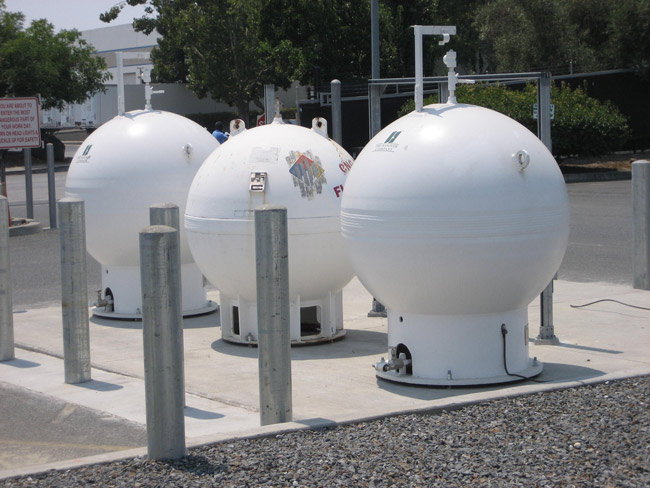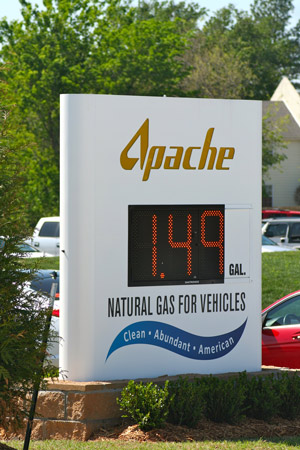
The last couple of years, Palm Coast has been thinking of converting its fleet of vehicles to alternative fuels, among them compressed natural gas. Don’t expect the conversion to begin just yet. The Palm Coast City Council heard a proposal to begin adapting some of the city’s 258 vehicles to compressed gas, heard the costs and the obstacles, and opted to pass, for now, despite the high cost of gasoline and the low cost of natural gas.
But the city administration had a surprise for the council: if and when the city begins making the conversion, it should think of building its own refueling station, not rely on Waste Pro’s, the garbage hauler, as council members thought they would when they signed on to a five-year extension with Waste Pro a few months ago.
Natural gas conversion’s potential gained momentum in the last few months for two reasons. As part of its contract renewal with Waste Pro, the city is requiring the garbage hauler to build a new gas fueling facility in Bunnell by June 1 next year. Waste Pro itself plans to convert its fleet to so-called CNG trucks, which burn fuel more cleanly (leaving about half the carbon footprint of gas trucks). Steeply rising gas prices and plummeting natural gas prices have also encouraged companies and governments to make the switch.
The city’s F-250 and F-350 Super-Duty pick-ups could theoretically be converted to natural gas. Another fuel tank (equivalent in size to an 18.4-gallon tank) would have to be installed, generally in a trunk, or the rear or bed of a pick-up truck. A different gauge and an injection rack would also have to be installed, along with a few other adjustments. The base price for such conversions is projected at $10,000 to $20,000. Tony Capela, a public works supervisor who made the natural gas presentation to the council this morning, was not ready, when asked, to estimate how long it would take the city to recoup its investment. Nor was he able to get the cost of a gas-gallon equivalent for natural gas beyond a range of $2 to $3 per gallon.

“From what I’ve been told, I’m not sure how much availability we’ll have for a fleet in Bunnell, for our fueling needs,” Capela said.
That was a new one on the council or the public, because the Waste Pro contract renewal was sold to both on the strength of a few factors, among them Waste Pro’s promise of a fueling facility that would not only accommodate Palm Coast’s fleet, but potentially that of other local governments as well. “It’s important that we look at all of the aspects, whether it’s worth us investing having our own fueling station whether at public works or Utility Drive,” Capela continued. “We could definitely utilize the Waste Pro fueling station, and I think that’s what the plan is. We just don’t know how it’s going to work and how convenient it’s going to be, either for them or for us.”
City Manager Jim Landon clarified: the city is very interested in looking for alternative fuels and burning fuel more cleanly, but with limits. “Right now is not the time. So we’re not proposing to build a filling station,” Landon said.

Yes, Waste Pro will build a facility, Landon said, but he called it a chicken-and-egg issue: how to convert a vehicle for a type of fuel that’s not yet available? “What we’re saying right now is we need to keep looking at our options, but that this year the timing isn’t right,” he said. Still, he downplayed the feasibility of a city fleet refueling at a Waste Pro facility, again appearing to lay the groundwork for a facility of Palm Coast’s own–should the city finally embrace natural gas conversion in the future. Council member Jason DeLorenzo suggested the city and the school board could be partners in such a venture. “Verbal estimates” of the cost of a facility range between $300,000 and $600,000, according to the city.
“Bottom line is,” Mayor Jon Netts said, “the CNG issue was raised by Waste Pro, was part of their proposal, they offered us access to their fueling station as if and when, city council said to staff look into this, see if it’s an option. I think from what I’m hearing, at least for this year, it’s not an option, let’s wait until the fueling station is in, see how it works for them. Then we can always, as Bill said, either do our own retrofits, or as we purchase new vehicles, purchase them with the conversion already in place. Right now, for this year, status quo.”
So the council went back to looking at fleet replacement as it has every year, the conventional way. The city was on a five-year replacement schedule. It has altered that to a seven-year, $100,000-mile “vehicle check” schedule. If the vehicle is still in decent shape, it’s kept yet another year. The deciding is not cosmetic but mechanical, Capela said.
The council agreed to spend $189,204 to replace eight trucks and an Explorer SUV, all but one with mileage over 100,000. Six of the vehicles are for the utilities department, one is for parks, one for public works, and one for administrative uses. The money accumulates year after year in a special account to enable just such annual replacements. See the list of vehicles being replaced here.





























anon says
This is not the first time around.
The city had an opportunity to purchase green vehicles several years ago. The green city council said no.
One council member even offered a different plan for vehicle purchase. And that was blown off.
There was a natural gas pipeline installed on route 1 in the recent past.
Couldn’t someone in the city government have secured a federal grant for construction of a natural gas filling station and then encouraged the county and Bunnell to participate?
How could a city that calls itself green operate so far behind the curve?
SOCRATESL says
AS USUAL, CITY MANAGER LANDON HAS LED THE COUNCIL BY THEIR COLLECTIVE NOSES TO AWARD WASTE PRO THE CONTRACT. NONE OF THE COUNCIL, INCLUDING THE MAYOR,, INTELLIGENTLY COMPLETELY EXPLORED ALL ASPECTS OF THE CONTRACT AND THEIR VIABILITY. WHY? BECAUSE AS MANY TIMES IN THE PAST, THEY DO NOT POSSESS THE NECESSARY INTELLIGENCE TO DO SO.
palmcoastpioneers says
1972 – The Palm Coasts Project position on Air Pollution:
( An Approach to a New City: Palm Coast ) Page 140, 1972 Environmental Affairs:
O Preservation of Natural Areas
Studies: A master plan was developed to determine the open space requirements , and all other land use requirement, of the population that will ultimately live in Palm Coast. A species study is presently underway so that the open speaces requirements of indiginous flora and fauna may be met ( See Section N avobe).
Solution. The establishment of over 15,000 acres of open space within the development which will meet the needs of all species living, or projected to live, within the planning area. The preservation of large tracts of open area in their natural state will be assured in order to retain the existing features which now dominate in these areas.
P. Air Pollution Control
Solutions: On a national basis, transportation is the greatest source of air pollution — especially the gasoline powered motor vehicle, which emits major portions of carbon monoxide, hydrocarbons, and nitrogen oxides. Fuesl combustion in the stationary sources is another lesser but still important source of sulphur oxides, particulates, and nitrogen oxides. Industrial processing accounts for high loadings of carbon monoxide, particulates, and sulphur oxides. At Palm Coast, the fuel combustion and industrial source components will be negligible, due to stringent control based on pre-planning. The mechanism for accomplishing this will be discussed lated in the Industrial Pollution Control Section.
It is therefore obviousl that transportation, especially in the form of the automobile, will be the major potential air pollution source for which controls will be needed. However, rapid technological advances by automobile manufacturers have made exhaust emission control achieveable in the foreseeable future. Our contribution to control of transportation pollution is to plan for modes of living which substantially reduce automobile use. This concept features plannin which emplasized bicycle paths, walking distance to shop
Page 140
ping centers, boating to shopping, and the use of electric minibuses. And, of course, low density in land use takes advantage of the air’s vast dilutive and natural assimilative capacity.
PJ says
Landon again, can you believe this and you can’t make this bull up.
Landon has all these politicians believing that that you can convert diesel engines to CNG. You can but not without major expense. You can convert gas vehicles but it is not worth the effort either. The return on the capitol investment is not for a broke city like Plam coast.
Flagler county/ Bunnell they are already exploring the concept. However their managers tell their boards it is expensive and not con them with a sweetheart contract to a company because oh just beacuse they said “sure you can have CNG depot and yea well build it” if you give us that contract sales pitch.
So now every council member thinks it was their idea, folks you have not had an orginal idea since Ladon arrived.
Enough of all the bashing the facts are as stated. It is expensive build so make Waste pro put the fueling station in.
All of the local municipalities should start replacing vehicles for CNG vehicles and when it gets big enough that it is not good to use the Waste Pro site, then and only then you build your own.
So hold Waste Pro’s feet to the fire and please Palm Cost politicians stop making it like it is your idea to go CNG.
The dog and pony show Landon put on for you was just to satisfy the part of the waste pro agreement that Landon and company were actually doing something for the sake of the contract.
However it really is not going anywhere fast………………………………………….
John Boy says
NS JAX got rid of their entire fleet of almost 100 pick up trucks. These vehicles where used on a fixed location of about 25 square miles. If they didn’t show a benefit there why would they work here in an area covering many times the square miles? There was a public auction and many of the vehicles garnered bid of less than $3,000.
Stanley Wu says
Great. Just make sure that it doesn’t go boom!